Katalonien |
|
|
|
| Übersicht – Contents: | |
Diese Seite ist Teil des Projektes
Katalonien |
|
|
|
| Übersicht – Contents: | |
Flagge – Flag: |
|
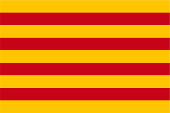 |
seit/since 1977, |
| historische und andere Flaggen – historical and other Flags: | |
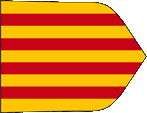 |
875–14. Jhd./century, |
 |
14.–16. Jhd./century, |
 |
1933–1935, |
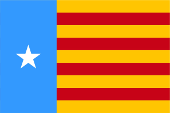 |
1933–1935, |
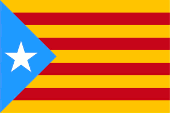 |
1933–1935, |
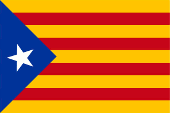 |
Flagge der Unabhängigkeitsbewegung |
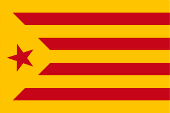 |
Flagge der Unabhängigkeitsbewegung |
Bedeutung/Ursprung der Flagge – Meaning/Origin of the Flag: |
|
| Die heutige Flagge Kataloniens wurde am 18.12.1979 offiziell wieder eingeführt. Sie wird Senyera genannt und zeigt vier horizontale rote Streifen auf goldenem Grund. Es ist eine typische Wappenflagge, die durch Drehung und Befestigung des Wappenbildes an einem Flaggstock entstanden ist. König Ramiro II. von Aragón setzte vor seinem Tod im Jahre 1137 seine neugeborene Tochter Petronella als Erbin ein, die im Jahre 1150 Raimund Berengar IV., den Grafen von Barcelona (Katalonien) heiratete. So entstand die vereinigte Krone von Aragonien unter dem Wappen von Raimund Berengar IV., die 1228–1232 um die Balearen und um 1238 noch um die Grafschaft Valencia erweitert wurde. Für die vereinigte Krone von Aragonien wird die sehr einprägsame Flagge der Grafschaft Barcelona/Fürstentum Katalonien übernommen, die – wie deren Wappen – vier senkrechte rote Balken auf goldenem Grund zeigt. Die vereinigte Krone von Aragonien wurde im Jahre 1715 aufgelöst, Katalonien wurde spanische Provinz, blieb jedoch die nominelle Grafschaft Barcelona. In der Spanischen Republik (ab 1931), wurde am 21.09.1932 eine Autonome Region Katalonien gegründet, welche die Senyera am 25.05.1933 offiziell wieder annahm. In der Zwischenzeit hatten aber bereits inoffizielle Varianten der Flagge verwendet, die am Mast zusätzlich ein hellblaues Dreieck oder einen hellblauen Balken mit einem weißen fünfzackigen Stern darin zeigten. Die Autonomie war dann 1935 wieder abgeschafft worden, allerdings durfte das Parlament ab 1936 wieder eingeschränkt werden um eine neue Regierung zu bilden, die jetzt wahrscheinlich/vermutlich die vorher inoffizielle Variante mit dem hellblauen Balken und dem weißen fünfzackigen Stern darin verwendete. Die Senyera war zwischen 1939 und 1975 unter der Regentschaft des spanisch-nationalistischen General Franco verboten. Politische und kulturelle Gruppen der Neuzeit, welche die Identität von Katalonien erhalten und fördern wollen, oder gar die Unabhängigkeit des Landes wünschen, verwenden die Flagge Kataloniens meist ergänzt um ein blaues Dreieck am Mast mit einem weißen fünfzackigen Stern in der Mitte, "Estelada Blava" genannt. Es gibt aber auch eine Variante mit einem gelben Dreieck am Mast und einem roten Stern, "Estelada Groga" genannt, die von linken Nationalisten verwendet wird. |
The current flag of
Catalonia was officially reintroduced on 18th of December in 1979. It is called Senyera
and shows four horizontal red stripes on a golden background. It is a
typical heraldic flag, created by rotating and attaching the heraldic image
to a flagpole. Before his death in 1137, King Ramiro II of Aragon appointed his newborn daughter Petronella as heiress, who married Raimund Berengar IV, Count of Barcelona (Catalonia) in 1150. Thus was born the united Crown of Aragon under the arms of Raimund Berengar IV, which was extended to include the Balearic Islands in 1228–1232 and the county of Valencia in 1238. For the united Crown of Aragon, the very memorable flag of the County of Barcelona/Principality of Catalonia is adopted, which – like its coat of arms – shows four vertical red bars on a golden background. The united Crown of Aragon was dissolved in 1715, Catalonia became a Spanish province, but remained the nominal county of Barcelona. In the Spanish Republic (from 1931), an Autonomous Region of Catalonia was created on 21st of September in 1932, which officially re-adopted the Senyera on 25th of May in 1933. In the meantime, however, unofficial variants of the flag had already been used, which additionally showed a light blue triangle on the mast or a light blue bar with a white five-pointed star in it. Autonomy was then abolished again in 1935, but parliament was allowed to be restricted again from 1936 to form a new government, which now probably/presumably used the previously unofficial variant with the light blue bar and the white five-pointed star in it. The Senyera was banned between 1939 and 1975 under the reign of the Spanish nationalist General Franco. Political and cultural groups of modern times that want to preserve and promote the identity of Catalonia, or even desire the independence of the country, usually use the flag of Catalonia supplemented by a blue triangle on the mast with a white five-pointed star in the middle, called "Estelada Blava". However, there is also a variant with a yellow triangle on the pole and a red star, called "Estelada Groga", which is used by left-wing nationalists. |
| Quelle/Source: Wikipedia (ES), Flags of the World, Volker Preuß | |
Wappen – Coat of Arms: |
|
 |
seit/since 1977, Wappen von Katalonien – coat of arms of Catalonia, Quelle/Source, nach/by: Xavi Garcia, CC BY-SA 3.0, via Wikimedia Commons |
historische Wappen – historical Coats of Arms: |
|
 |
ab/from ca. 12. Jahrhundert / 12th century, Wappen der Grafen von Barcelona – coat of arms of the Counts of Barcelona, Quelle/Source, nach/by: Wikipedia (DE) |
Bedeutung/Ursprung des Wappens – Meaning/Origin of the Coat of Arms: |
|
| Das heutige Wappen von Katalonien wurde, wie die Flagge, im, Zusammenhang mit der Errichtung der Autonomen Gemeinschaft Katalonien am 29.09.1977 offiziell wieder eingeführt, es zeigt vier rote Balken auf goldenem Grund, darüber eine Königskrone. Das Schild ist das Wappen der Grafschaft Barcelona und der späteren vereinigten Krone von Aragonien 1150. König Ramiro II. von Aragón setzte vor seinem Tod im Jahre 1137 seine neugeborene Tochter Petronella als Erbin ein, die im Jahre 1150 Raimund Berengar IV., den Grafen von Barcelona (Katalonien) heiratete. So entstand die vereinigte Krone von Aragonien unter dem Wappen von Raimund Berengar IV., die 1228–1232 um die Balearen und um 1238 noch um die Grafschaft Valencia erweitert wurde. Das Wappen der Grafschaft Barcelona wurde eine Legende folgend um 875 durch den westfränkischen König Karl der Kahle an den Wilfried den Behaarten (Guifré el Pilós), den Grafen von Barcelona verliehen, weil er beim Kampf gegen die Mauren (Araber) Tapferkeit gezeigt hatte. Die Legende berichtet das ein Kämpfer die vier blutenden Finger seiner Hand durch das bis dahin gültige Wappen des Grafen zog. Graf Raimund Berengar III. von Barcelona hat jedoch um das Jahr 1100 eine völlig andere Interpretation seines Wappens aufzeichnen lassen, die folgendes überliefert: Das Wappen ist rot und zeigt drei goldene Balken. Sie stehen für die drei Säulen der Macht in der Grafschaft Barcelona, nämlich Barcelona selbst, die Herrschaft Besalú und die Herrschaft Provenca. Möglicherweise geht die ab 1263 von Aragonien angeblich verwendete Marineflagge auf diese Interpretation zurück. Die Farben Rot und Gold gehen angeblich auf den Einfluss des Papstes zurück, denn das alte Königreich Aragon und die Grafschaft Barcelona waren Lehen des Heiligen Stuhls, und verwendeten deshalb die Farben der Stadt Rom. |
The present coat of arms
of Catalonia, like the flag, was officially reintroduced in connection with
the creation of the Autonomous Community of Catalonia on 29th of September in 1977. It
shows four red bars on a golden background, above which is a royal crown.
The shield is the coat of arms of the County of Barcelona and of the later united Crown of Aragon in 1150. Before his death in 1137, King Ramiro II of Aragon appointed his newborn daughter Petronella as heiress, who married Raimund Berengar IV, Count of Barcelona (Catalonia) in 1150. Thus was born the united Crown of Aragon under the arms of Raimund Berengar IV, which was extended to include the Balearic Islands in 1228-1232 and the county of Valencia in 1238. According to legend, the coat of arms of the County of Barcelona was granted to Wilfried the Hairy (Guifré el Pilós), Count of Barcelona, by the West Frankish King Charles the Bald around 875, because he had shown bravery in the fight against the Moors (Arabs). Legend has it that a fighter drew the four bleeding fingers of his hand through the count's coat of arms, which was valid until then. Count Raimund Berengar III of Barcelona, however, had a completely different interpretation of his coat of arms drawn up around the year 1100, which records the following: The coat of arms is red and shows three golden bars. They stand for the three pillars of power in the County of Barcelona, namely Barcelona itself, the Lordship of Besalú and the Lordship of Provenca. It is possible that the naval flag allegedly used by Aragon from 1263 onwards goes back to this interpretation. The colours red and gold allegedly go back to the influence of the Pope, because the old kingdom of Aragon and the county of Barcelona were fiefs of the Holy See, and therefore used the colours of the city of Rome. |
| Quelle/Source: Wikipedia (ES), Wikipedia (CA), Volker Preuß | |
|
Die autonomen Regionen Spaniens – The autonomous Regions of Spain: Interaktive Landkarte - interactive map |
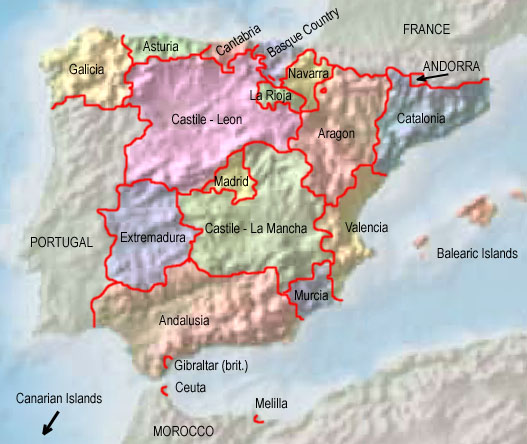 |
| Quelle/Source: Freeware, University of Texas Libraries, modyfied by: Volker Preuß |
|
Karte der historischen Königreiche auf der Iberischen Halbinsel (ca. 1220) – Map of the historical Kingdoms on the Iberian Peninsula (ca. 1220): Interaktive Landkarte - interactive map |
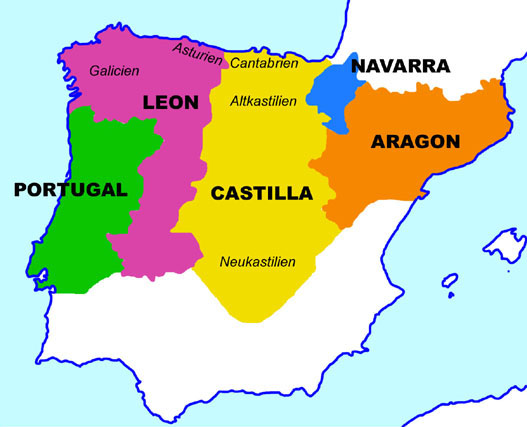 |
| Landkarte/map by: Volker Preuß |
Zahlen und Fakten – Numbers and Facts: |
|
|
|
|
|
|
|
|
|
|
|
|
|
|
|
Geschichte: |
|
Frühzeit
· Besiedlung durch Iberer ca. 600 v.Chr. · Einwanderung von Kelten, Vermischung mit den Iberern, Herausbildung der Keltiberer 218–201 v.Chr. · Zweiter Punischer Krieg, das Römische Reich erwirbt die Besitzungen Karthagos in Iberien, Unterwerfung der ganzen Iberischen Halbinsel bis zum Jahre 19 v.Chr. 217 v.Chr. · das heutige Katalonien kommt zur römischen Provinz Hispania Tarraconensis, römische Besiedlung, Romanisierung ca. 400 n.Chr. · Völkerwanderung, Durchzug von Alanen, germanischen Sweben und Westgoten, ein Teil der Alanen siedelt im Pyrenäenvorland 415 · zum Westgotenreich 711–714 · Vernichtung des Westgotenreichs durch von Nordafrika kommende Araber 714 · die Araber erobern Katalonien 778 · das Frankenreich unter Karl dem Großen erobert Katalonien, Errichtung der Spanischen Mark im Pyrenäenvorland, jedoch Niederlage gegen die Basken im Tal von Ronceval 795–812 · Wiedererrichtung der Spanischen Mark durch Karl den Großen und Ludwig den Frommen, dem Sohn von Karl dem Großen ca.820–ca.880 · Krise des Frankenreichs nach dem Tod von Karl dem Großen, Aufteilung des Reiches, Erbfolgestreitigkeiten, in der Spanischen Mark werden die fränkischen Markgrafen vertrieben und durch gewählte lokale Dynastien ersetzt, in Katalonien vereinigt Graf Wilfried der Behaarte (Guifré el Pilós) die Grafschaften Urgell, Cerdanya, Barcelona und Girona und begründet die Dynastie der Grafen von Barcelona, die sich allmählich vom Fränkischen Reich unabhängig machen 1137 · Ramiro II., König von Aragonien, verlobt seine Tochter Pedronella mit Raimund Berengar IV., dem Grafen von Barcelona 1150 · Hochzeit von Pedronella und Raimund Berengar 1162 · Alfons II., Sohn von Raimund Berengar wird Graf von Barcelona 1163 · Alfons II. wird König von Aragonien (damit Vereinigung von Aragonien und Katalonien) 1172 · Aragonien erwibt die Grafschaft Roussillon und die Cerdagne (zeitweise auch Montpellier und Carcassonne) 1196–1213 · Herrschaft von König Pedro II. 1213–1276 · Herrschaft von König Jakob I. 1228–1232 · Aragonien erwibt die Balearen 1238 · Befreiung von Valencia von den Moslems 1248 · Befreiung von Alicante von den Moslems 1276–1285 · Herrschaft von König Peter III. 1282 · Aragonien erwibt Sizilien („Sizilianische Vesper”, Vertreibung der Anjou aus Palermo), Krieg mit Frankreich 1283 · Steuererhöhung, die Stände von Aragonien erzwingen vom König das Generalprivilegium von Saragossa 1285–1291 · Herrschaft von König Alfons III., Kriege mit Kastilien und Frankreich, die Stände werden stärker 1291–1327 · Herrschaft von König Jakob II., dem Bruder von Alfons III. 1326 · Aragonien erwibt Sardinien 1319 · die Unteilbarkeit des Reiches (Erbteilung) wird gesetzlich festgeschrieben, weiterhin eigene Ständeversammlungen (Cortes) in Katalonien und Valencia 1327–1336 · Herrschaft von König Alfons IV., dem Sohn von Jakob II., Kriege im Bündnis mit Kastilien gegen Genua und die Araber 1336–1387 · Herrschaft von König Peter IV., dem Sohn von Alfons IV., Ende des Krieges gegen Genua, teilweiser Verlust von Sardinien, Krieg gegen Kastilien, Bruderkrieg gegen die anderen Söhne von Alfons IV., die Stände werden stärker 1387–1395 · Herrschaft von König Johann, dem Sohn von Peter IV., Verlust von Sardinien 1410 · Tod von König Martin, dem Bruder von Johann, Aussterben der Dynastie Ramiros von Navarra 1410–1412 · Thronstreitigkeiten, per Schiedsspruch wird Ferdinand I. von Kastilien, ein Neffe von König Johann, König von Aragonien 1412–1416 · Herrschaft von König Ferdinand I. 1416–1458 · Herrschaft von König Alfons V., dem Sohn von Ferdinand I., Regentschaft durch seine Gemahlin Maria von Kastilien und seinem Bruder Johann, Alfons V. erobert das Königreich Neapel (1442) vom Haus Anjou und vereinigt Neapel und Sizilien mit Aragonien, Konflikte mit Frankreich 1458 · Tod von Alfons V., sein Sohn Ferdinand wird König in Neapel, sein Bruder Johann II. wird König von Aragonien (verheiratet mit Blanka von Navarra, somit auch König von Navarra, Abtretung des Roussillon an Frankreich 1479 · Tod von König Johann II., Nachfolger wird sein Sohn Ferdinand II. 1469 · Heirat von Isabella I., Königin von Kastilien-León und Ferdinand II., dem Prinzen und Thronfolger von Aragonien 1479 · Krönung von Ferdinand II. und Isabella I. zu Königen von Spanien 1516 · offizielle Vereinigung von Aragonien und Kastilien, Aragonien behält jedoch wichtige Privilegien 1609 · König Philipp III. von Spanien verweist die letzten Moslems (Morisken) des Landes 1701–1714 · Spanischer Erbfolgekrieg, Aragonien ergreift für Östrereich Partei, nach der Niederlage Verlust der Privilegien, Ende des selbstständigen Königtums der Vereinigten Krone von Aragonien, Katalonien, die Balearen und Valencia werden ausgegliedert, Aragonien (in seinen heutigen Grenzen), und Valencia behalten nominell den Titel eines Königreichs, Katalonien wird nominelles Fürstentum Barcelona 1808–1813 · Katalonien ist durch französische Truppen besetzt 1833 · die bis dato in Spanien bestehenden Teilkönigreiche und Regionen werden in Provinzen aufgeteilt, das Fürstentum Barcelona in die Provinzen Lérida, Gerona, Barcelona und Tarragona 1931 · Autonomiestatut für Katalonien 1936–1939 · Spanischer Bürgerkrieg, in Katalonien hält sich bis 1938 eine "Anarchistenrepublik" bis zur Zerschlagung durch die sozialistischen Regierungstruppen, ab 1938/1939 unter Kontrolle der Franco-Truppen, Ende der Autonomie 29.09.1977 · Katalonien erhält das Autonomiestatut innerhalb Spaniens (unter Zusammenfassung der Provinzen Lérida, Gerona, Barcelona und Tarragona), Gründung der "Autonomen Gemeinschaft Katalonien" 2006 · Neufassung des Autonomiestatuts, Vergrößerung der Autonomierechte von Katalonien 27.10.2017 · das Parlament von Katalonien erklärt nach einer Volksabstimmung die Unabhängkeit Kataloniens von Spanien, die Zentralregierung in Madrid entmachtet die Regionalregierung und ordnet Neuwahlen für Katalonien an |
History: |
|
early age
· settlement by Iberians ca. 600 B.C. · immigration of Celts, mix with the Iberians, evolution of the Celtiberians 218–201 B.C. · Second Punic War, the Roman Empire acquires the possessions of Carthago in Iberia, subjugation of whole Iberia until the year 19 B.C. 217 B.C. · the today’s Catalonia comes to the Roman province of Hispania Tarraconensis, Roman settlement, romanization ca. 400 A.D. · Great Transmigration (Migration Period), immigration of Teutonic Alans, teutonic Suebs and Western Goth, some of the Alans settle in the foreland of the Pyrenees Mountains 415 · to the Empire of the Western Goth 711–714 · annihilation of the Empire of the Western Goth by from northern Africa coming Arabs 714 · the Arabs conquer Catalonia 778 · the Frankish Empire under Carl the Great conquers Catalonia, establishment of the Spanish Mark in the foreland of the Pyrenees Mountains, but defeat against the Basques in the Valley of Ronceval 795–812 · re-establishment of the Spanish Mark by Carl the Great and his son Ludvig the Pious ca.820–ca.880 · crisis of the Frankish Empire after the death of Carl the Great, sharing out of the empire, succession quarrels, the Frankish margrave become banished in the Spanish Mark and were substituted by elected local dynasties, in Catalonia unites Count Wilfried the Hairy (Guifré el Pilós) the Counties of Urgell, Cerdanya, Barcelona and Girona and establishes the dynasty of the Counts of Barcelona which become more and more independent from the Frankish Empire 1137 · Ramiro II., King of Aragon, engages his daughter Pedronella with Raimund Berengar IV., the Count of Barcelona 1150 · wedding of Pedronella and Raimund Berengar 1162 · Alfons II., son of Raimund Berengar becomes Count of Barcelona 1163 · Alfons II. becomes king of Aragon (in this way unification of Aragon and Catalonia) 1172 · Aragon acquires the County of Roussillon and the Cerdagne (momentary even Montpellier and Carcassonne) 1196–1213 · times of the rule of king Pedro II. 1213–1276 · times of the rule of king Jakob I. 1228–1232 · Aragon acquires the Balearic Islands 1238 · liberation of Valencia from the Muslims 1248 · liberation of Alicante from the Muslims 1276–1285 · times of the rule of king Peter III. 1282 · Aragon acquires Sicily Island („Sicilian Vespers”, expulsion of the house of Anjou out of Palermo), war with France 1283 · increase of tax, the estates of Aragon compel from the king the General Privilege of Saragossa 1285–1291 · times of the rule of king Alfons III., wars with Castile and France, the estates become stronger 1291–1327 · times of the rule of king Jacob II., the brother of Alfons III. 1326 · Aragon acquires Sardinia Island 1319 · the non-divisibility of the empire (sharing out because of heritage) becomes fixed by law, furthermore own corporate assemblys (Cortes) in Catalonia and Valencia 1327–1336 · times of the rule of king Alfons IV., the son of Jacob II., wars in alliance with Castile against Genua and the Arabs 1336–1387 · times of the rule of king Peter IV., the son of Alfons IV., end of the war against Genua, partial loss of Sardinia, war against Castile, brother war against the other sons of Alfons IV., the estates become stronger 1387–1395 · times of the rule of king Johann, the son of Peter IV., loss of Sardinia 1410 · death of King Martin, the brother of Johann, vanish of the dynasty of Ramiro of Navarra 1410–1412 · throne quarrels, by arbitrage becomes Ferdinand I. of Castile – a nephew of king Johann - king of Aragon 1412–1416 · times of the rule of king Ferdinand I. 1416–1458 · times of the rule of king Alfons V., the son of Ferdinand I., regency by his consort Maria of Castile and his brother Johann, Alfons V. conquers the Kingdom of Naples (1442) from the house of Anjou and unites Naples and Sicily with Aragon, conflicts with France 1458 · death of Alfons V., his son Ferdinand becomes king in Naples, his brother Johann II. becomes king of Aragon (married with Blanca of Navarra, in this way even king of Navarra, ceding of the Roussillon to France 1479 · death of king Johann II., successor is his son Ferdinand II. 1469 · marriage of Isabella I., Queen of Castile-Leon and Ferdinand II., the Prince and Throne-Successor of Aragon 1479 · coronation of Ferdinand II. and Isabella I. to kings of Spain 1516 · official unification of Aragon and Castile, but Aragon withholds important privileges 1609 · king Philipp III. of Spain banishes the last Muslims (Moresques) out of the country 1701–1714 · Spanish succession war, Aragon positiones itself at the side of Austria, after the defeat loss of the privileges, end of the independent kingship of the United Crown of Aragon, Catalonia, the Balearic Islands and Valencia become outsourced, Aragon (in its today’s borders) and Valencia withhold nominally the title of a kingdom, Catalonia becomes nominally the Principality of Barcelona 1808–1813 · Catalonia is occupied by French troops 1833 · the until that point in time in Spain existing partial kingdoms and regions become divided in provinces, the Principality of Barcelona in the provinces of Lérida, Gerona, Barcelona and Tarragona 1931 · statute of autonomy for Catalonia 1936–1939 · Spanish Civil War, in Catalonia exists until 1938 an "Anarchist Republic" until the conquest by the socialistic governmental troops, since 1938/1939 under control of the troops of General Francol, end of the autonomy 29.09.1977 · Catalonia gets the statute of autonomy within Spain (by summary of the provinces of Lérida, Gerona, Barcelona and Tarragona), establishment of the "Autonomous Community of Catalonia" 7th of May 2006 · revision of the autonomy statute, enlargement of the autonomy rights of Catalonia 27th of October in 2017 · the parliament of Catalonia declares after a referendum the independence of Catalonia from Spain, the central government in Madrid displaces the regional government and orders new elections for Catalonia |
| Quelle/Source: Wikipedia (ES), World Statesmen, RetroBib Retrobibliothek, Volker Preuß |
Ursprung des Landesnamens – Origin of the Country's Name: |
|
| Der Name "Katalonien" geht auf die hier siedelnden "Katalanen" zurück. Die Bezeichnung "Katalanen" entstand, als sich im 5. Jahrhundert die hier lebenden Alanen mit den Goten zu den "Got-Alanen" vermischten. | The name
"Catalonia" goes back to the here living "Catalans". The name "Catalans" arised in the 5th century as the here living Alans mixed with the Goth to the "Goth-Alans". |
| Quelle/Source: Die Völker der Erde | |